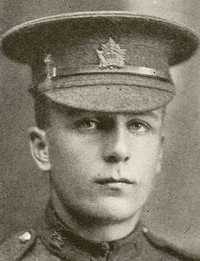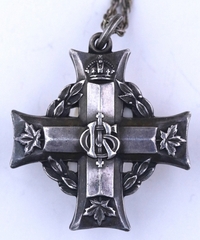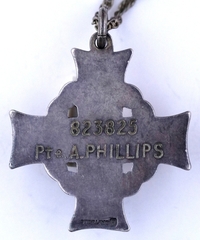
823825 Private Allan Phillips
142nd Canadian Overseas Battalion, CEF
18th Canadian Infantry Battalion, CEF
By: Capt (ret'd) Michael M. O'Leary, CD, The RCR


Photo credit: Pte. Phillips — 1918. The Christmas Echo: Honour Roll Number. LLSC. (From Topography of Grief
Allan Phillips was born in London, England, on 21 Apr 1897. Phillip's family, led by parents Charles Joseph (40) and Mary Elizabeth (nee Blomfield) (36) emigrated to Canada in 1910. The family, with three children, Charles, Jr. (19), Allan (12), and Elsie (10), can be found on the passenger list for the Canadian Pacific steamship S.S. Lake Manitoba which sailed from Liverpool, Eng., and arrived at Quebec on 11 May 1910.
The Phillips family are living in London, Ont., in the records of the Canadian Census for 1911. The family resides at 241 William St. Charles, Sr. and Charles, Jr., are both working for the iron foundry and manufacturer McClary's, the elder as a packer and the younger as a receiver. Allan (13) is listed as working parcel delivery for dry goods.
Allan Phillips attested for service in the Canadian Expeditionary Force (C.E.F.) with the 142nd Overseas Battalion at London, Ont., on 2 May 1916. A 19-year-old bank clerk working for the Royal Bank of Canada, Phillips was described on his attestation paper as 5 feet 6 3/4-inches tall, weighing 152 pounds, with a 34-inch chest, a fresh complexion, blue eyes, and light brown hair. His religious denomination was Baptist (this is a change from the family's religion recorded as Church of England at the time of their move to Canada). Phillips identified his father, Charles Joseph Phillips, 169 High St., London, Ont., as his next of kin. On attesting with the 142nd Battalion, Phillips was given the regimental number 823825.
The 142nd (London's Own) Battalion, C.E.F. was formed in London, Ont., where the unit began recruiting in late 1915 and the unit trained at Wolseley Barracks. As the unit's training period was coming to a close, Phillips completed a military Form of Will on 30 Sep 1916. In the event of his death, he bequeathed all of his estate to his mother.
Sailing from Canada on 1 Nov 1916 aboard the S.S. Southland, the 142nd Battalion arrived in England on 11 Nov 1916. The soldiers of the battalion, including Phillips, were absorbed into the 23rd Reserve Battalion, C.E.F., at Dibgate on 11 Nov 1916.
Once he was in England, Phillips established a monthly Pay Assignment of $20 to be sent to his mother. As a Private in the C.E.F., Phillips was paid $1.00 per day plus an additional ten cents daily field allowance. His pay assignment represented about two-thirds of his monthly pay.
Phillips was the subject of a summary trial on 2 Dec 1916 for being absent without leave. Found guilty of being A.W.L. from 30 Nov to 1.10 a.m. 1 Dec 1916, he was awarded three days Field Punishment No. 2 and forfeited one day's pay. Field Punishment No. 2 was the requirement to execute extra work and drill for the duration of the sentence.
On 4 Jan 1917, Phillips was transferred from the 23rd Res. Bn. to the 4th Res. Bn. at West Sandling. One month later, on 2 Feb 1917, he was appointed Acting Lance Corporal, with pay.
Phillips completed a new will document on 13 Apr 1917 using the page in his Pay Book designed for that purpose. His new will stated: "I, Allan Phillips, Reg No 823825, serving in the 4th Res Battn CEF do hereby leave all my possessions and all my private property to my mother, Mrs C.J. Phillips, 169 High St., London, Ont., Canada." The page was witnessed by another soldier originally from the 142nd Bn., 823483 Pte. G.H. Frost.
Only one week after completing his new will, on 21 Apr 1917, Phillips was struck off the strength of the 4th Res. Bn. to join a draft of reinforcements for the 18th Canadian Infantry Battalion. Before crossing the Channel to France, it was necessary that he voluntarily revert to the rank of Private. This was a normal measure, the fighting battalions in France and Flanders did not want non-commissioned officers without front line experience, preferring instead to promote experienced men from within their own ranks. Those men who reverted in rank and proved themselves at the front often quickly rose again in rank with their new units.
Phillips arrived at the Canadian Base Depot, Havre, on 22 Apr 1917 and was taken on the strength of the 18th Cdn. Inf. Bn. He waited at the Depot for one month, joining the 18th Battalion in the field on 21 May 1917.
The 18th Battalion was working on improving an observation trench named Ridge Line the day Phillips reported to the unit. That work was halted the following day after which the troops had three quiet days before returning to front line positions. Phillips' first experience of the forward trenches was a unit tour from 26 to 29 May 1917. Having taken over the positions from the 28th Battalion on the night of 26 May, the following day was noted for active artillery fire all along the line. This, as it turned out, was a precursor for attempted German raids on the 28th. The Germans were repulsed, but the battalion suffered some casualties, including the men of a wiring party that was caught in No Man's Land at the time of the raids. The 18th Bn. was relieved in turn by the 21st Bn. on the night of 29 May 1917. Phillips had survived his first experience of the combat zone.
Relieved in early June, 1917, by the 1st Canadian Infantry Division, the 2nd Division went into a period of rest that would last over five weeks. It was a rest period with little empty time for the troops. There were parades for baths, pay, clothing, and church. Recreational training and sports, musketry, and bayonet fighting were all on the schedule. Units soldiers competed in brigade, divisional and Corps sports competitions (with the 18th Battalion's football team winning the Corps championship). Throughout June, 1917, and the first week of July, Phillips would have had a good opportunity to refresh all of his training and to fully integrate with his new unit.
On 9 Jul 1917, the night before the unit went back to the front line of trenches, an unfortunate incident struck the 18th Bn. In the early afternoon a long range German shell struck a hut occupied by men of Headquarters Details and "D" Company. The cost to the battalion was five dead, four died of wounds, and another 35 wounded. Late the following day, 10 Jul 1917, the 18th Battalion returned to the trenches and relieved the 26th Bn. in the Lens Sector.
The 18th Bn. had a quiet tour of the lines from 10 to 12 July 1917. Their next tour was 16 to 22 Jul 1917, one marked by the enemy's regular application of trench mortar and artillery fire. Relieved on the 22nd of July, the battalion went into a short period of rest at Bouvigny. The rest period, as usual a misnomer for soldiers, started with baths and pay parades, and was then followed by two days of special training for the assault. After the training, the battalion spent most of the next six days actually at rest, with training cancelled due to heavy rains.
On 4 Aug 1917, the 18th Bn. went back to the front lines. After three days of providing carrying parties for Trench Mortar batteries, the battalion relieved the 19th Bn. on 8 Aug 1917. The following day, the 18th Bn. executed successful raids on the German front trenches to a depth of 100 yards. That night, relieved by the 27th and 31st Bns., the 18th returned to billets in Bouvigny for rest and baths.
After only three days in billets, the 18th Bn. returning to the line and relieved the 27th Bn. on the night of 13 Aug 1917. In the early morning hours of the following night, 14/15 Aug 1917, the 18th Battalion was the right forward unit of the 4th Brigade in the 2nd Division's assault at Hill 70. The battalion attacked with two companies forward, one in close support and one in reserve. The War Diary notes:
"At 4.25 a.m. the 18th Battalion in conjunction with other units of the 1st, and 2nd Canadian Divisions attacked the enemy lines ... the object being to capture and consolidate the enemy support line (CHICORY TRENCH)... The attack was entirely successful and 26 minutes after zero hour (4.25 a.m.) we occupied our objectives, capturing some 65 prisoners (165 R.I.R.)."
Continuing the attack on the 16th and 17th of August, the 18th Bn. consolidated its gains. On the night of 18 Aug 1917, the battalion was relieved by companies of the 27th and 50th Bns. and went to Bully-Grenay for rest and baths. On 21 Aug 1917, the unit was to move from Bully-Grenay to Bouvigny Huts and a period in Corps Reserve.
Allan Phillips was killed in action on 21 Aug 1917. A notation in his service record reads, "Killed by enemy shell bursting on road." The War Diary for the 18th Cdn. Inf Bn. Provides the following entry for that date: "The Battalion left BULLY-GRENAY at 9.30 a.m. and proceeded to BOUVIGNY HUTS going into Corps Reserve. On the road "D" Coy sustained 52 casualties, 23 of which were fatal, by the bursting of an enemy shell (high velocity). This bringing our casualties to approximately 220 during the tour."
The Circumstances of Death record held by Library and Archives Canada for Phillips provides the following details for his death: "Killed in action — He was killed by an enemy shell which exploded close to him on the road near Aix-Noulette."
Phillips is buried in the Aix-Noulette Communal Cemetery Extension. The register entry for the cemetery reads: "PHILLIPS, Pte. Allan, 823825. 18th Bn. Canadian Inf. (Western Ontario Regt.). 21st Aug., 1917. Age 20. Son of Charles J. And Mary Elizabeth Phillips, of 169 High St., London, Ontario. I.M.9." At the base of the Commonwealth War Graves Commission gravestone marking Phillips' grave, the text chosen by his parents reads: "Until the Day Break, and the Shadows Flee Away. Sol. 2nd, 17th Verse."
For his service in the C.E.F., Phillips was entitled to receive the British War Medal and the Victory Medal. These were despatched to his parents at London, Ont., on 25 Mar 1922. They would also receive the Memorial Plaque and Scroll commemorating his death. Phillip's mother would also receive a silver Memorial Cross. The plaque and cross would be despatched in 1920 and 1921.
Topography of Grief
In 2017, the Public History Class of 2017 at Western University, in conjunction with The Royal Canadian Regiment Museum, developed a project titled "Topography of Grief. Mapping Great War Dead in London, ON (1914 — 1921)." The project identified 343 next of kin addresses for fallen soldiers from London, Ont. Of these, 95 were selected for further study and presentation as part of the project. Private Allan Phillips was one of these soldiers.
Pro Patria
Visit a randomly selected page in The O'Leary Collection (or reload for another choice):
- The O'Leary Collection; Medals of The Royal Canadian Regiment.
- Researching Canadian Soldiers of the First World War
- Researching The Royal Canadian Regiment
- The RCR in the First World War
- Badges of The RCR
- The Senior Subaltern
- The Minute Book (blog)
- Rogue Papers
- Tactical Primers
- The Regimental Library
- Battle Honours
- Perpetuation of the CEF
- A Miscellany
- Quotes
- The Frontenac Times
- Site Map
QUICK LINKS
The O'Leary Collection—Medals of The Royal Canadian Regiment
Newest additions:
![]()
![]() SB-12725 Private Henry "Hank" Ard
SB-12725 Private Henry "Hank" Ard ![]()
WIA at Hill 187, Died of Wounds in Japan
![]()
![]() 2355331 Lance Corporal Albert Lorking
2355331 Lance Corporal Albert Lorking
Wounded in action, later a War Amps representative.
![]()
![]() 4334 / 477996 Pte Isaac Hamilton Wilcox
4334 / 477996 Pte Isaac Hamilton Wilcox
Permanent Force, South Africa, and C.E.F.
![]()
![]() 477019 Private Harold Ashcroft
477019 Private Harold Ashcroft
Transferred to the Tunnelers.
![]()
![]() 734231 Private Clark D. Thompson
734231 Private Clark D. Thompson ![]()
The older Thompson brother, killed in action.
![]()
![]() 733849 Private Norman Parker Thompson
733849 Private Norman Parker Thompson
The younger Thompson brother; post-war service in the Special Guard.
![]()
![]()
![]() A305 / 400305 Private Andrew Walker
A305 / 400305 Private Andrew Walker ![]()
"Previously reported Wounded, now Killed in Action."
![]()
![]() 823298 Pte Thomas Patrick Steele, M.M.
823298 Pte Thomas Patrick Steele, M.M. ![]()
… for gallant conduct in the field …
![]()
![]() P13066 Sergeant Harold Thompson
P13066 Sergeant Harold Thompson
Instrumental Soloist for over 20 years of Canadian Army service.
![]()
![]() 9609 / 477728 Private Albert Edward Piper
9609 / 477728 Private Albert Edward Piper
"Arrived from England as a STOWAWAY …"


